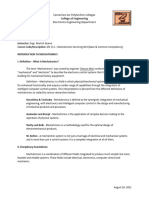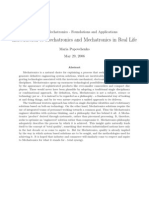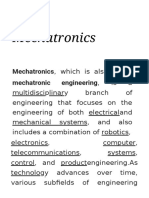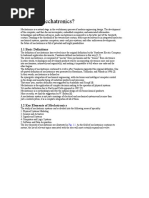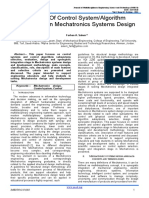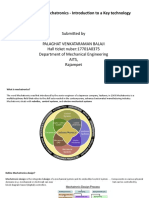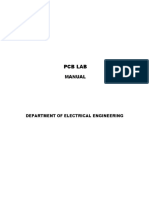Mechetronics
Mechetronics
Uploaded by
Venugopal kulkarniCopyright:
Available Formats
Mechetronics
Mechetronics
Uploaded by
Venugopal kulkarniOriginal Title
Copyright
Available Formats
Share this document
Did you find this document useful?
Is this content inappropriate?
Copyright:
Available Formats
Mechetronics
Mechetronics
Uploaded by
Venugopal kulkarniCopyright:
Available Formats
This page intentionally left blank
Confirming Pages
C H A P T E R 1
Introduction
CHAPTER OBJECTIVES
After you read, discuss, study, and apply ideas in this chapter, you will be able to:
1. Define mechatronics and appreciate its relevance to contemporary engineering
design
2. Identify a mechatronic system and its primary elements
3. Define the elements of a general measurement system
1.1 MECHATRONICS
Mechanical engineering, as a widespread professional practice, experienced a surge
of growth during the early 19th century because it provided a necessary founda-
tion for the rapid and successful development of the industrial revolution. At that
time, mines needed large pumps never before seen to keep their shafts dry, iron
and steel mills required pressures and temperatures beyond levels used commer-
cially until then, transportation systems needed more than real horse power to move
goods; structures began to stretch across ever wider abysses and to climb to dizzying
heights, manufacturing moved from the shop bench to large factories; and to support
these technical feats, people began to specialize and build bodies of knowledge that
formed the beginnings of the engineering disciplines.
The primary engineering disciplines of the 20th century—mechanical, electrical,
civil, and chemical—retained their individual bodies of knowledge, textbooks, and
professional journals because the disciplines were viewed as having mutually exclu-
sive intellectual and professional territory. Entering students could assess their indi-
vidual intellectual talents and choose one of the fields as a profession. We are now
witnessing a new scientific and social revolution known as the information revolution,
where engineering specialization ironically seems to be simultaneously focusing and
diversifying. This contemporary revolution was spawned by the engineering develop-
ment of semiconductor electronics, which has driven an information and communi-
cations explosion that is transforming human life. To practice engineering today, we
alc80237_ch01_001-010.indd 1 1/3/11 3:36 PM
Confirming Pages
2 CHAPTER 1 Introduction
must understand new ways to process information and be able to utilize semicon-
ductor electronics within our products, no matter what label we put on ourselves as
practitioners. Mechatronics is one of the new and exciting fields on the engineering
landscape, subsuming parts of traditional engineering fields and requiring a broader
approach to the design of systems that we can formally call mechatronic systems.
Then what precisely is mechatronics? The term mechatronics is used to denote
a rapidly developing, interdisciplinary field of engineering dealing with the design of
products whose function relies on the integration of mechanical and electronic com-
Internet Link ponents coordinated by a control architecture. Other definitions of the term “mecha-
tronics” can be found online at Internet Link 1.1. The word mechatronics was coined
1.1 Definitions of
in Japan in the late 1960s, spread through Europe, and is now commonly used in the
“mechatronics”
United States. The primary disciplines important in the design of mechatronic sys-
tems include mechanics, electronics, controls, and computer engineering. A mecha-
tronic system engineer must be able to design and select analog and digital circuits,
microprocessor-based components, mechanical devices, sensors and actuators, and
controls so that the final product achieves a desired goal.
Mechatronic systems are sometimes referred to as smart devices. While the term
smart is elusive in precise definition, in the engineering sense we mean the inclusion
of elements such as logic, feedback, and computation that in a complex design may
appear to simulate human thinking processes. It is not easy to compartmentalize
mechatronic system design within a traditional field of engineering because such
design draws from knowledge across many fields. The mechatronic system designer
must be a generalist, willing to seek and apply knowledge from a broad range of
sources. This may intimidate the student at first, but it offers great benefits for indi-
viduality and continued learning during one’s career.
Today, practically all mechanical devices include electronic components and
some type of computer monitoring or control. Therefore, the term mechatronic sys-
tem encompasses a myriad of devices and systems. Increasingly, microcontrollers
are embedded in electromechanical devices, creating much more flexibility and
control possibilities in system design. Examples of mechatronic systems include
an aircraft flight control and navigation system, automobile air bag safety system
and antilock brake systems, automated manufacturing equipment such as robots and
numerically controlled (NC) machine tools, smart kitchen and home appliances such
as bread machines and clothes washing machines, and even toys.
Figure 1.1 illustrates all the components in a typical mechatronic system. The
actuators produce motion or cause some action; the sensors detect the state of the
system parameters, inputs, and outputs; digital devices control the system; condi-
tioning and interfacing circuits provide connections between the control circuits and
the input/output devices; and graphical displays provide visual feedback to users.
The subsequent chapters provide an introduction to the elements listed in this block
diagram and describe aspects of their analysis and design. At the beginning of each
chapter, the elements presented are emphasized in a copy of Figure 1.1. This will
Internet Link help you maintain a perspective on the importance of each element as you gradually
1.2 Online build your capability to design a mechatronic system. Internet Link 1.2 provides
mechatronics links to various vendors and sources of information for researching and purchasing
resources different types of mechatronics components.
alc80237_ch01_001-010.indd 2 1/3/11 3:36 PM
Confirming Pages
1.1 Mechatronics 3
MECHANICAL SYSTEM
- system model - dynamic response
ACTUATORS SENSORS INPUT SIGNAL
- solenoids, voice coils CONDITIONING Internet Link
- switches - strain gage
- DC motors - potentiometer - thermocouple AND INTERFACING
- stepper motors - photoelectrics - accelerometer 1.3 Segway
- servo motors - digital encoder - MEMs - discrete circuits - filters
- hydraulics, pneumatics - amplifiers - A/D, D/D human
transporter
OUTPUT SIGNAL DIGITAL CONTROL
GRAPHICAL CONDITIONING ARCHITECTURES
DISPLAYS AND INTERFACING - logic circuits - sequencing and timing
- LEDs - LCD - microcontroller - logic and arithmetic
- digital displays - CRT
- D/A, D/D - power transistors - SBC - control algorithms
Video Demo
- amplifiers - power op amps
- PWM - PLC - communication
1.1 Adept One
robot demon-
Figure 1.1 Mechatronic system components.
stration
1.2 Adept One
robot internal
Example 1.1 describes a good example of a mechatronic system—an office
design and
copy machine. All of the components in Figure 1.1 can be found in this common
construction
piece of office equipment. Other mechatronic system examples can be found on
1.3 Honda
the book website. See the Segway Human Transporter at Internet Link 1.3, the
Asimo Raleigh,
Adept pick-and-place industrial robot in Video Demos 1.1 and 1.2, the Honda NC, demon-
Asimo and Sony Qrio humanoid-like robots in Video Demos 1.3 and 1.4, and stration
the inkjet printer in Video Demo 1.5. As with the copy machine in Example 1.1, 1.4 Sony “Qrio”
these robots and printer contain all of the mechatronic system components shown Japanese dance
in Figure 1.1. Figure 1.2 labels the specific components mentioned in Video demo
Demo 1.5. Video demonstrations of many more robotics-related devices can be found 1.5 Inkjet printer
components
Mechatronic System—Copy Machine EXAMPLE 1.1
An office copy machine is a good example of a contemporary mechatronic system. It includes
analog and digital circuits, sensors, actuators, and microprocessors. The copying process
works as follows: The user places an original in a loading bin and pushes a button to start the
process; the original is transported to the platen glass; and a high intensity light source scans
the original and transfers the corresponding image as a charge distribution to a drum. Next, a
blank piece of paper is retrieved from a loading cartridge, and the image is transferred onto
the paper with an electrostatic deposition of ink toner powder that is heated to bond to the
paper. A sorting mechanism then optionally delivers the copy to an appropriate bin.
Analog circuits control the lamp, heater, and other power circuits in the machine. Digital
circuits control the digital displays, indicator lights, buttons, and switches forming the user
interface. Other digital circuits include logic circuits and microprocessors that coordinate all
of the functions in the machine. Optical sensors and microswitches detect the presence or
absence of paper, its proper positioning, and whether or not doors and latches are in their cor-
rect positions. Other sensors include encoders used to track motor rotation. Actuators include
servo and stepper motors that load and transport the paper, turn the drum, and index the sorter.
alc80237_ch01_001-010.indd 3 1/3/11 3:36 PM
Confirming Pages
4 CHAPTER 1 Introduction
DC motors with piezoelectric
belt and gear drives inkjet head
digital
encoders
with
photo-
interrupters
limit
switches
Internet Link
printed circuit boards
LED light tube
with integrated circuits
1.4 Robotics
video Figure 1.2 Inkjet printer components.
demonstrations
1.5 Mechatronic
system video at Internet Link 1.4, and demonstrations of other mechatronic system examples can
demonstrations be found at Internet Link 1.5.
■ CLASS DISCUSSION ITEM 1.1
Household Mechatronic Systems
What typical household items can be characterized as mechatronic systems? What
components do they contain that help you identify them as mechatronic systems?
If an item contains a microprocessor, describe the functions performed by the
microprocessor.
1.2 MEASUREMENT SYSTEMS
A fundamental part of many mechatronic systems is a measurement system com-
posed of the three basic parts illustrated in Figure 1.3. The transducer is a sensing
device that converts a physical input into an output, usually a voltage. The signal
processor performs filtering, amplification, or other signal conditioning on the
transducer output. The term sensor is often used to refer to the transducer or to the
combination of transducer and signal processor. Finally, the recorder is an instru-
ment, a computer, a hard-copy device, or simply a display that maintains the sensor
data for online monitoring or subsequent processing.
alc80237_ch01_001-010.indd 4 1/3/11 3:36 PM
Confirming Pages
1.3 Threaded Design Examples 5
signal
transducer recorder
processor
Figure 1.3 Elements of a measurement system.
These three building blocks of measurement systems come in many types with
wide variations in cost and performance. It is important for designers and users of
measurement systems to develop confidence in their use, to know their important
characteristics and limitations, and to be able to select the best elements for the mea-
surement task at hand. In addition to being an integral part of most mechatronic
systems, a measurement system is often used as a stand-alone device to acquire data
in a laboratory or field environment.
Measurement System—Digital Thermometer EXAMPLE 1.2
The following figure shows an example of a measurement system. The thermocouple is a
transducer that converts temperature to a small voltage; the amplifier increases the magni-
tude of the voltage; the A/D (analog-to-digital) converter is a device that changes the analog
signal to a coded digital signal; and the LEDs (light emitting diodes) display the value of
the temperature.
thermocouple LED display
amplifier
A/D
and
display
decoder
signal processor recorder
transducer
Supplemental information important to measurement systems and analysis is
provided in Appendix A. Included are sections on systems of units, numerical preci-
sion, and statistics. You should review this material on an as-needed basis.
1.3 THREADED DESIGN EXAMPLES
Throughout the book, there are Examples, which show basic analysis calculations,
and Design Examples, which show how to select and synthesize components and
subsystems. There are also three more complicated Threaded Design Examples,
which build upon new topics as they are covered, culminating in complete mecha-
tronic systems by the end. These designs involve systems for controlling the position
and speed of different types of motors in various ways. Threaded Design Examples
A.1, B.1, and C.1 introduce each thread. All three designs incorporate components
important in mechatronic systems: microcontrollers, input devices, output devices,
sensors, actuators, and support electronics and software. Please read through the
alc80237_ch01_001-010.indd 5 1/3/11 3:36 PM
Confirming Pages
6 CHAPTER 1 Introduction
following information and watch the introductory videos. It will also be helpful to
watch the videos again when follow-on pieces are presented so that you can see how
everything fits in the “big picture.” The list of Threaded Design Example citations at
the beginning of the book, with the page numbers, can be useful for looking ahead or
reflecting back as new portions are presented.
All of the components used to build the systems in all three threaded designs
are listed at Internet Link 1.6, along with descriptions and price information. Most
of the parts were purchased through Digikey Corporation (see Internet Link 1.7)
and Jameco Electronics Corporation (see Internet Link 1.8), two of the better online
suppliers of electronic parts. By entering part numbers from Internet Link 1.6 at the
supplier websites, you can access technical datasheets for each product.
THREADED DESIGN EXAMPLE
A.1 DC motor power-op-amp speed controller—Introduction
This design example deals with controlling the rotational speed of a direct current (DC) perma-
nent magnet motor. Figure 1.4 illustrates the major components and interconnections in the sys-
tem. The light-emitting diode (LED) provides a visual cue to the user that the microcontroller is
running properly. The speed input device is a potentiometer (or pot), which is a variable resistor.
The resistance changes as the user turns the knob on top of the pot. The pot can be wired to pro-
Internet Link duce a voltage input. The voltage signal is applied to a microcontroller (basically a small com-
puter on a single integrated circuit) to control a DC motor to rotate at a speed proportional to the
1.6 Threaded
voltage. Voltage signals are “analog” but microcontrollers are “digital,” so we need analog-to-
design example
components digital (A/D) and digital-to-analog (D/A) converters in the system to allow us to communicate
between the analog and digital components. Finally, because a motor can require significant
1.7 Digikey
electronics current, we need a power amplifier to boost the voltage and source the necessary current. Video
supplier Demo 1.6 shows a demonstration of the complete working system shown in Figure 1.5.
1.8 Jameco With all three Threaded Design Examples (A, B, and C), as you progress sequentially
electronics through the chapters in the book you will gain fuller understanding of the components in the
supplier design.
light-emitting diode
indicator
Video Demo power
amp
1.6 DC motor
power-op-amp A/D D/A
speed controller
potentiometer DC
for setting speed digital-to-analog
motor
converter
PIC microcontroller
with analog-to-digital
converter
Figure 1.4 Functional diagram of the DC motor speed controller.
alc80237_ch01_001-010.indd 6 1/3/11 3:36 PM
Confirming Pages
1.3 Threaded Design Examples 7
pot
voltage
D/A
regulator
PIC
digital power amp
encoder with heat sink
DC motor gear
drive
inertial
load
Figure 1.5 Photograph of the power-amp speed controller.
Note that the PIC microcontroller (with the A/D) and the external D/A converter are not
actually required in this design, in its current form. The potentiometer voltage output could
be attached directly to the power amp instead, producing the same functionality. The reason
for including the PIC (with A/D) and the D/A components is to show how these components
can be interfaced within an analog system (this is useful to know in many applications). Also,
the design serves as a platform for further development, where the PIC can be used to imple-
ment feedback control and a user interface, in a more complex design. An example where you
might need the microcontroller in the loop is in robotics or numerically controlled mills and
lathes, where motors are often required to follow fairly complex motion profiles in response to
inputs from sensors and user programming, or from manual inputs.
THREADED DESIGN EXAMPLE
Stepper motor position and speed controller—Introduction B.1
This design example deals with controlling the position and speed of a stepper motor, which
can be commanded to move in discrete angular increments. Stepper motors are useful in posi-
tion indexing applications, where you might need to move parts or tools to and from various
fixed positions (e.g., in an automated assembly or manufacturing line). Stepper motors are also
useful in accurate speed control applications (e.g., controlling the spindle speed of a computer
hard-drive or DVD player), where the motor speed is directly proportional to the step rate.
alc80237_ch01_001-010.indd 7 1/3/11 3:36 PM
Confirming Pages
8 CHAPTER 1 Introduction
light-
emitting
diode
potentiometer
A/D
stepper
mode button PIC motor
driver
stepper
microcontroller motor
position buttons
Figure 1.6 Functional diagram of the stepper motor position and speed controller.
Figure 1.6 shows the major components and interconnections in the system. The input
devices include a pot to control the speed manually, four buttons to select predefined posi-
tions, and a mode button to toggle between speed and position control. In position control
mode, each of the four position buttons indexes the motor to specific angular positions rela-
tive to the starting point (0⬚, 45⬚, 90⬚, 180⬚). In speed control mode, turning the pot clockwise
(counterclockwise) increases (decreases) the speed. The LED provides a visual cue to the user
to indicate that the PIC is cycling properly. As with Threaded Design Example A, an A/D
Video Demo converter is used to convert the pot’s voltage to a digital value. A microcontroller uses that
1.7 Stepper value to generate signals for a stepper motor driver circuit to make the motor rotate.
motor position and Video Demo 1.7 shows a demonstration of the complete working system shown in Figure 1.7.
speed controller As you progress through the book, you will learn about the different elements in this design.
speed stepper motor
pot PIC driver
mode
button
position
buttons
A/D
motion
indicator
stepper
motor
Figure 1.7 Photograph of the stepper motor position and speed controller.
alc80237_ch01_001-010.indd 8 1/3/11 3:36 PM
Confirming Pages
1.3 Threaded Design Examples 9
THREADED DESIGN EXAMPLE
DC motor position and speed controller—Introduction C.1
This design example illustrates control of position and speed of a permanent magnet DC
motor. Figure 1.8 shows the major components and interconnections in the system. A numeri-
cal keypad enables user input, and a liquid crystal display (LCD) is used to display messages
and a menu-driven user interface. The motor is driven by an H-bridge, which allows the volt-
age applied to the motor (and therefore the direction of rotation) to be reversed. The H-bridge
also allows the speed of the motor to be easily controlled by pulse-width modulation (PWM),
where the power to the motor is quickly switched on and off at different duty cycles to change
the average effective voltage applied.
A digital encoder attached to the motor shaft provides a position feedback signal. This
signal is used to adjust the voltage signal to the motor to control its position or speed.
This is called a servomotor system because we use feedback from a sensor to control
the motor. Servomotors are very important in automation, robotics, consumer electronic
devices, flow-control valves, and office equipment, where mechanisms or parts need to be
accurately positioned or moved at certain speeds. Servomotors are different from stepper
motors (see Threaded Design Example B.1) in that they move smoothly instead of in small
incremental steps.
Two PIC microcontrollers are used in this design because there are a limited number of
input/output pins available on a single chip. The main (master) PIC gets input from the user,
drives the LCD, and sends the PWM signal to the motor. The secondary (slave) PIC monitors
the digital encoder and transmits the position signal back to the master PIC upon command
via a serial interface. Video Demo
Video Demo 1.8 shows a demonstration of the complete working system shown in
1.8 DC motor
Figure 1.9. You will learn about each element of the design as you proceed sequentially
position and
through the book. speed controller
liquid crystal display
microcontrollers
1 2 3
4 5 6 keypad
7 8 9 decoder
quadrature
MASTER SLAVE
* 0 # decoder
PIC PIC
and counter
keypad
button
H-bridge
buzzer driver
DC motor with
digital position encoder
Figure 1.8 Functional diagram for the DC motor position and speed controller.
alc80237_ch01_001-010.indd 9 1/3/11 3:37 PM
Confirming Pages
10 CHAPTER 1 Introduction
master DC
buzzer PIC H-bridge motor
keypad
keypad
decoder
slave
PIC
encoder
counter
LCD
Figure 1.9 Photograph of the DC motor position and speed controller.
BIBLIOGRAPHY
Alciatore, D. and Histand, M., “Mechatronics at Colorado State University,” Journal of
Mechatronics, Mechatronics Education in the United States issue, Pergamon Press,
May, 1995.
Alciatore, D. and Histand, M., “Mechatronics and Measurement Systems Course at Colorado
State University,” Proceedings of the Workshop on Mechatronics Education, pp. 7–11,
Stanford, CA, July, 1994.
Ashley, S., “Getting a Hold on Mechatronics,” Mechanical Engineering, pp. 60–63, ASME,
New York, May, 1997.
Beckwith, T., Marangoni, R., and Lienhard, J., Mechanical Measurements, Addison-Wesley,
Reading, MA, 1993.
Craig, K., “Mechatronics System Design at Rensselaer,” Proceedings of the Workshop on
Mechatronics Education, pp. 24–27, Stanford, CA, July, 1994.
Doeblin, E., Measurement Systems Applications and Design, 4th edition, McGraw-Hill, New
York, 1990.
Morley, D., “Mechatronics Explained,” Manufacturing Systems, p. 104, November, 1996.
Shoureshi, R. and Meckl, P., “Teaching MEs to Use Microprocessors,” Mechanical Engi-
neering, v. 166, n. 4, pp. 71–74, April, 1994.
alc80237_ch01_001-010.indd 10 1/3/11 3:37 PM
You might also like
- Proposal For Vehicle Tracking System With GPS+GSMDocument6 pagesProposal For Vehicle Tracking System With GPS+GSMssaqui50% (4)
- AVR ManualDocument29 pagesAVR Manualgarridt100% (1)
- THE Mechatronics Handbook: Robert H. BishopDocument15 pagesTHE Mechatronics Handbook: Robert H. Bishopİbrahim Kayğan50% (2)
- SR02 01DSDocument4 pagesSR02 01DSharis_fikriNo ratings yet
- Introduction To Mechatronics and Measurement Systems D&M-21-30Document10 pagesIntroduction To Mechatronics and Measurement Systems D&M-21-30ahmed abdbastNo ratings yet
- Use of Mechatronics in Today's Industry: A Review: Shaheed Bhagat Singh State Technical Campus, FerozepurDocument5 pagesUse of Mechatronics in Today's Industry: A Review: Shaheed Bhagat Singh State Technical Campus, FerozepurSankit IngaleNo ratings yet
- (PDF) Assignment 1 - Introduction To MechatronicsDocument4 pages(PDF) Assignment 1 - Introduction To MechatronicskyeligoyoNo ratings yet
- MTX C.S A.deshpande, R.bagul, P.dharme, S.ingaleDocument5 pagesMTX C.S A.deshpande, R.bagul, P.dharme, S.ingaleSankit IngaleNo ratings yet
- Chapter 1 - Introduction To MechatronicsDocument12 pagesChapter 1 - Introduction To MechatronicsaguirreNo ratings yet
- Introduction To Mechatronics and Mechatronics in Real LifeDocument13 pagesIntroduction To Mechatronics and Mechatronics in Real LifeNaza HadiramadanNo ratings yet
- Future Trends in MechatronicsDocument8 pagesFuture Trends in MechatronicsIAES International Journal of Robotics and AutomationNo ratings yet
- Module 2.3 WESETDocument217 pagesModule 2.3 WESETbelalabdu24No ratings yet
- Andi Ihzan IznainDocument15 pagesAndi Ihzan IznainAndi Ihzan IznainNo ratings yet
- Introduction To Mechatronics 1Document76 pagesIntroduction To Mechatronics 1Daniel PedroNo ratings yet
- What Is MechatronicsDocument8 pagesWhat Is MechatronicsAxel PiñaNo ratings yet
- Mechatronics: Electrical EngineeringDocument8 pagesMechatronics: Electrical EngineeringAkshayNo ratings yet
- Mechatronics - WikipediaDocument9 pagesMechatronics - WikipediavirothsovyNo ratings yet
- Mechatronics: A Multidisciplinary Field of Engineering: Manzoor Elahi SoudagarDocument3 pagesMechatronics: A Multidisciplinary Field of Engineering: Manzoor Elahi SoudagarRohith KrishnaNo ratings yet
- Recent Trends in Mechatronic SystemDocument11 pagesRecent Trends in Mechatronic SystemFaria Sultana MimiNo ratings yet
- SocietyDocument7 pagesSocietyumbutt78601No ratings yet
- Advance in MechatronicsDocument6 pagesAdvance in Mechatronicsj rNo ratings yet
- The What, Why and How in MechatronicsDocument8 pagesThe What, Why and How in MechatronicsradiokillerNo ratings yet
- What Is Mechatronics ?Document7 pagesWhat Is Mechatronics ?Jayakrishna KandasamyNo ratings yet
- Introduction To MechatronicsDocument9 pagesIntroduction To MechatronicsZakiah MuhlisNo ratings yet
- Mechatronic Systems-Innovative Products With Embedded ControlDocument16 pagesMechatronic Systems-Innovative Products With Embedded ControlJEFF PUPIALESSNo ratings yet
- Issues: Sensor Technologies and Microsensor For Mechatronics SystemsDocument11 pagesIssues: Sensor Technologies and Microsensor For Mechatronics SystemsalfredokpuNo ratings yet
- Microprocessor Based: Control Systems: A First Step in Teaching MechatronicsDocument5 pagesMicroprocessor Based: Control Systems: A First Step in Teaching MechatronicsGauravNo ratings yet
- MechatronicsDocument44 pagesMechatronicsTboi100% (1)
- 259 - Lecturer NotvfvvervrevDocument81 pages259 - Lecturer NotvfvvervrevBijay KumarNo ratings yet
- What Is MechatronicsDocument7 pagesWhat Is Mechatronicsislameslamoislam807No ratings yet
- Unit 1 INTRODUCTION TO MECHATRONICS SYSTEM DESIGNDocument8 pagesUnit 1 INTRODUCTION TO MECHATRONICS SYSTEM DESIGN9740177035100% (1)
- English Corner- MECHATRONICSDocument9 pagesEnglish Corner- MECHATRONICSMame Mariama DIOPNo ratings yet
- MECATRONICADocument5 pagesMECATRONICAJuan Julio DelgadoNo ratings yet
- Final Year Project Report Writing GuidelinesV5.0Document8 pagesFinal Year Project Report Writing GuidelinesV5.0Ridzuan RahmanNo ratings yet
- Ch01intro To MechatronicsDocument6 pagesCh01intro To MechatronicsElizabeth PaulNo ratings yet
- Chapter 1 - Introduction To Mechatronic DevicesDocument12 pagesChapter 1 - Introduction To Mechatronic Devicesmohd_mizanNo ratings yet
- 11 Engineering Education For MechatronicsDocument7 pages11 Engineering Education For MechatronicsAlexander HE100% (1)
- Algoritmi Upravljanja Mehatronickih SistemaDocument19 pagesAlgoritmi Upravljanja Mehatronickih SistemazileNo ratings yet
- History of mechatronics and generation of mechatronic modules,Document14 pagesHistory of mechatronics and generation of mechatronic modules,benmossesgeorgeNo ratings yet
- CHAPTER 1 IntroductionDocument12 pagesCHAPTER 1 IntroductionKetul ShahNo ratings yet
- ME442 Chapter1Document13 pagesME442 Chapter1AlanNo ratings yet
- Intro To MechatronicsDocument30 pagesIntro To MechatronicsUrvashi ParmarNo ratings yet
- M.Module 1Document39 pagesM.Module 1Jishnu PrakashNo ratings yet
- Mechatronics WikiDocument4 pagesMechatronics WikibekkuNo ratings yet
- Introduction To Mechatronics SystemDocument8 pagesIntroduction To Mechatronics SystemSomalia Wadankeyga100% (1)
- MechatronicsDocument32 pagesMechatronicskr_abhijeet72356587No ratings yet
- Lecture 1 Introduction to MechatronicsDocument59 pagesLecture 1 Introduction to Mechatronicsmilkalemayehu2727No ratings yet
- Mechatronics: Mechatronics, Also Called Mechatronics Engineering, Is AnDocument5 pagesMechatronics: Mechatronics, Also Called Mechatronics Engineering, Is AnMuhammed NehanNo ratings yet
- Introduction To MechatronicsDocument47 pagesIntroduction To MechatronicsChalle MontemayorNo ratings yet
- What Is Mechatronics?: Ieee/Asme Transactions On Mechatronics, Vol. MARCH 1996Document5 pagesWhat Is Mechatronics?: Ieee/Asme Transactions On Mechatronics, Vol. MARCH 1996Daniel Martinez100% (1)
- Mechatronics 1Document67 pagesMechatronics 1Syeda HusnaNo ratings yet
- Assignment On Mechatronics - Introduction To A Key TechnologyDocument8 pagesAssignment On Mechatronics - Introduction To A Key TechnologybalajiNo ratings yet
- Mechatronics 2 UnitDocument24 pagesMechatronics 2 UnitMukesh sutharNo ratings yet
- Electronics& MechatronicsDocument1 pageElectronics& MechatronicsEkluvya99No ratings yet
- Minimalist Grayscale Pitch Deck XL by SlidesgoDocument7 pagesMinimalist Grayscale Pitch Deck XL by Slidesgonvien2411No ratings yet
- Mechatronics: From Wikipedia, The Free EncyclopediaDocument4 pagesMechatronics: From Wikipedia, The Free EncyclopediaAnonymous SNjq7SN5XyNo ratings yet
- Mechatranics Module 1Document19 pagesMechatranics Module 1valoto4868No ratings yet
- Mechatronic Is The FutureDocument1 pageMechatronic Is The FutureCristian MarceloNo ratings yet
- What Is MechatronicsDocument11 pagesWhat Is MechatronicsKEVIN SNo ratings yet
- Mechatronics Notes Unit1Document4 pagesMechatronics Notes Unit1Varun BanurNo ratings yet
- Mechatronics System Design: Department of Mechatronics Engineering Dr. Mahmoud KaidDocument150 pagesMechatronics System Design: Department of Mechatronics Engineering Dr. Mahmoud Kaidalwah207No ratings yet
- Engineering the Future at the Intersection: Groundbreaking Advances in Mechanical EngineeringFrom EverandEngineering the Future at the Intersection: Groundbreaking Advances in Mechanical EngineeringNo ratings yet
- Designing Mechatronic Systems: Principles and Practices for Engineers: O7.0 TRANSFORM INFORMATION TECHNOLOGYFrom EverandDesigning Mechatronic Systems: Principles and Practices for Engineers: O7.0 TRANSFORM INFORMATION TECHNOLOGYNo ratings yet
- 01fe19bme175 InternshipDocument28 pages01fe19bme175 InternshipVenugopal kulkarniNo ratings yet
- 7.sme - HMT - Condensation and BoilingDocument81 pages7.sme - HMT - Condensation and BoilingVenugopal kulkarniNo ratings yet
- OPAMP NotesDocument19 pagesOPAMP NotesVenugopal kulkarniNo ratings yet
- Madhwa Guru ParamparaDocument2 pagesMadhwa Guru ParamparaVenugopal kulkarniNo ratings yet
- Phase 1 Refined Problem StatementDocument15 pagesPhase 1 Refined Problem StatementVenugopal kulkarniNo ratings yet
- Minor Project Template Phase 2Document5 pagesMinor Project Template Phase 2Venugopal kulkarniNo ratings yet
- Product Development Proposal-Template-UASDharwadDocument8 pagesProduct Development Proposal-Template-UASDharwadVenugopal kulkarniNo ratings yet
- HMT Chapter 1Document118 pagesHMT Chapter 1Venugopal kulkarniNo ratings yet
- Conduction - Part 1 - Heat and Mass TransferDocument39 pagesConduction - Part 1 - Heat and Mass TransferVenugopal kulkarniNo ratings yet
- 80010606V01 PDFDocument6 pages80010606V01 PDFIbrahim JaberNo ratings yet
- HVT DS Haefely Akv-9360 V2206-02Document4 pagesHVT DS Haefely Akv-9360 V2206-02sunilNo ratings yet
- DSD Lab Manual 2021Document21 pagesDSD Lab Manual 2021adityaNo ratings yet
- The Problem and Its BackgroundDocument3 pagesThe Problem and Its BackgroundJessanette San PabloNo ratings yet
- Layer 2 Framing HDLC (High-Level Data Linl Control) : Giuseppe BianchiDocument13 pagesLayer 2 Framing HDLC (High-Level Data Linl Control) : Giuseppe Bianchihassan_m2222No ratings yet
- Nano RadioDocument6 pagesNano RadioSudha MadhuriNo ratings yet
- EOS-261-U9-PET_44x20_260_043_044_045-52 (1)Document4 pagesEOS-261-U9-PET_44x20_260_043_044_045-52 (1)rodriguex23No ratings yet
- ISD715 Magnetic Transport Antenna 2Document1 pageISD715 Magnetic Transport Antenna 2ravikkotaNo ratings yet
- Obstacle Avoidance With Anti Theft Mechanism System and Cabin Safety System For AutomobilesDocument5 pagesObstacle Avoidance With Anti Theft Mechanism System and Cabin Safety System For AutomobilesseventhsensegroupNo ratings yet
- PCB Lab Manual For StudentsDocument18 pagesPCB Lab Manual For StudentsPallavi VarkuteNo ratings yet
- Course Syllabus: of TheDocument3 pagesCourse Syllabus: of Thedjun033No ratings yet
- KDC-MP443 KDC-MP3043 KDC-MP343 KDC-MP243 KDC-MP243SW: Instruction ManualDocument20 pagesKDC-MP443 KDC-MP3043 KDC-MP343 KDC-MP243 KDC-MP243SW: Instruction ManualsebastinNo ratings yet
- Samarth Cable VisionDocument13 pagesSamarth Cable VisionSandeep ShahNo ratings yet
- L3. Single Phase Ac Voltage ControllersDocument68 pagesL3. Single Phase Ac Voltage ControllersSourabh KhandelwalNo ratings yet
- L&T Mm30743 Motpro RelayDocument31 pagesL&T Mm30743 Motpro Relayanvesh_jadavNo ratings yet
- Types of MonitorsDocument5 pagesTypes of MonitorssukshradNo ratings yet
- NEXIQ_USB-LinkDocument1 pageNEXIQ_USB-Linkdtctruck22No ratings yet
- Mu Iso 04 GBDocument8 pagesMu Iso 04 GBjoepdekker1100% (1)
- UPS 3000X DatasheetDocument8 pagesUPS 3000X DatasheetLullaby summerNo ratings yet
- Design Automation For Differential MOS Current-Mode Logic CircuitsDocument235 pagesDesign Automation For Differential MOS Current-Mode Logic Circuitshenchiri.becherNo ratings yet
- Arduino Uno Based PIR Sensor.Document5 pagesArduino Uno Based PIR Sensor.rupu ghoshNo ratings yet
- NodeMCU Basic Project-Blink A LED - InstructablesDocument3 pagesNodeMCU Basic Project-Blink A LED - InstructablesGANESHNo ratings yet
- Bav99 NDocument4 pagesBav99 Nastrix37No ratings yet
- Infovision Optoelectronics (Kunshan) Co.,LtdDocument20 pagesInfovision Optoelectronics (Kunshan) Co.,Ltdsergio ribeiroNo ratings yet
- Subts 11Document29 pagesSubts 11Satheesh ChandranNo ratings yet
- Case Study of Complex Full Chip Low Power Implementation in 16nm NodeDocument32 pagesCase Study of Complex Full Chip Low Power Implementation in 16nm NodemanojkumarNo ratings yet
- Mn003626a01-Af Esla Slr1000 Bsim LacrDocument452 pagesMn003626a01-Af Esla Slr1000 Bsim LacrOscar EscobarNo ratings yet






